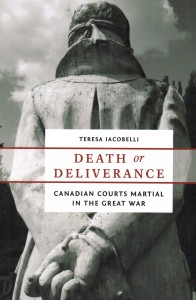In 2001 Veterans Affairs Canada added 23 names to the nation’s First World War Book Of Remembrance preserved in the Peace Tower. The 23 were shot for cowardice and desertion. Ron Duhamel, then-veterans affairs minister, told the Commons: “People may lose control of their emotions, have a breakdown for reasons over which they have little control,” he said. “I wish to express my deep sorrow at their loss of life”.
But what if this is all wrong? What if the image of the frail and cowering soldier executed by sadistic military brass is a First War set piece that owes more to filmography than fact?
Historian Teresa Iacobelli challenges readers to review the evidence in Death or Deliverance, as fascinating a case as ever went to the jury. Iacobelli asserts that not only were military executions extremely rare, but that Canadians’ view of the incidents – including Veterans Affairs’ 2001 observance – is skewed by a Hollywood film.
Stanley Kubrick’s 1957 production Paths of Glory depicts the execution of three innocent French soldiers convicted on trumped-up charges of cowardice. One reviewer called the story “grotesque,” “appalling” and “nauseating”. Adolphe Menjou is particularly good as the sociopathic General Broulard. Paths of Glory was filmed in Germany and not screened in France for many years.
Iacobelli has seen the film, too. “Those soldiers of the First World War who stood before firing squads have been portrayed as shell-shocked boys who had run out of the courage to withstand the trying circumstances,” she writes. “But was this really the case? Was military justice unnecessarily severe, and can we typify those soldiers who deserted?”
It turns out, no. Iacobelli meticulously reviews all instances of execution in the Canadian Expeditionary Force and comes to a striking conclusion. Execution was rare, the overwhelming majority of deserters were briefly jailed and commanders were sensitive to the “reputation” of deserters.
Canadians were subject to military law under the 1881 Army Act. Espionage was punishable by death as well as drinking on duty, cowardice, desertion and throwing away your rifle in combat. If the penalty appears brutal to modern readers, Death or Deliverance notes Canadians at the time found execution an acceptable punishment. Forty-eight hangings took place in Canadian jails during the war years, more than twice the number who were shot by the army.
“It was common for shell shock to be viewed by military authorities as a threat akin to malingering or the more serious crime of desertion and cowardice,” Iacobelli writes. Yet 90 percent of death sentences were commuted. And even a 1918 federal report acknowledged that “men who had committed serious military offences because of exhaustion or their loss of courage or for other reasons” deserved a “chance to save their reputation”.
Canada was not alone. No Australian was executed. The U.S. had 23 by official count, including soldiers convicted of felonies like rape and murder. Germany had 48.
Death or Deliverance has no drum roll, no Adolphe Menjou character. It is much better. “Enduring myths of the war easily fed into myths of the courts martial themselves,” Iacobelli writes. “Is it not true that the historian’s role is to explain rather than to judge?”
By Holly Doan
Death or Deliverance: Canadian Courts Martial in the Great War, by Teresa Iacobelli; University of British Columbia Press; 192 pages; ISBN 9780-7748-25689; $32.95






